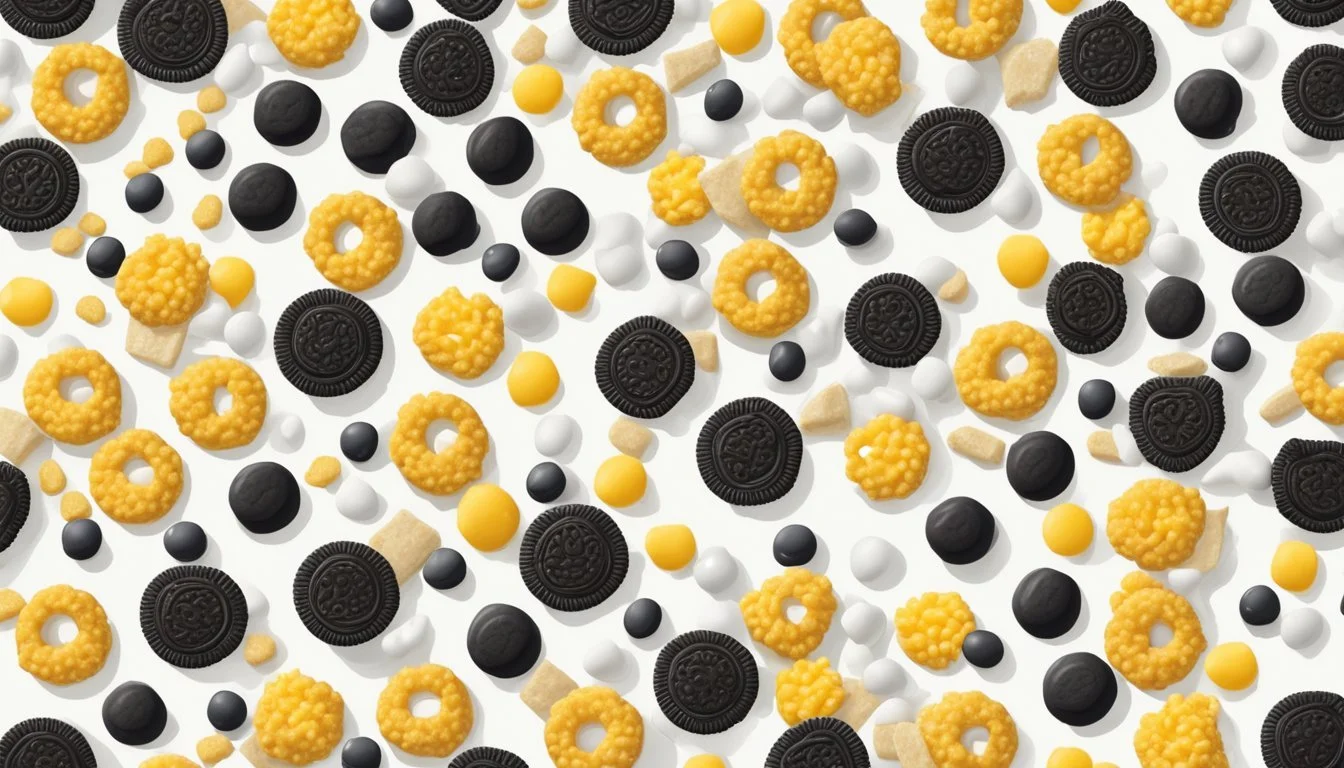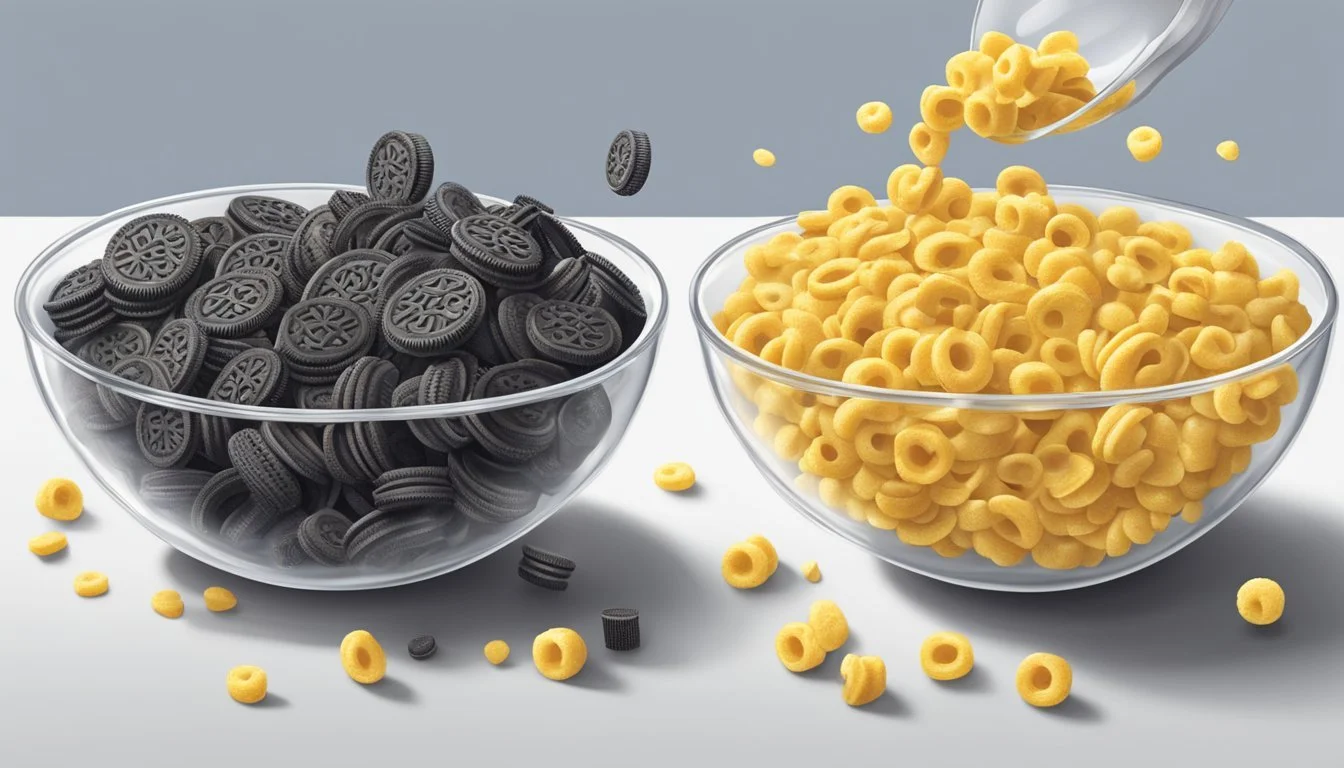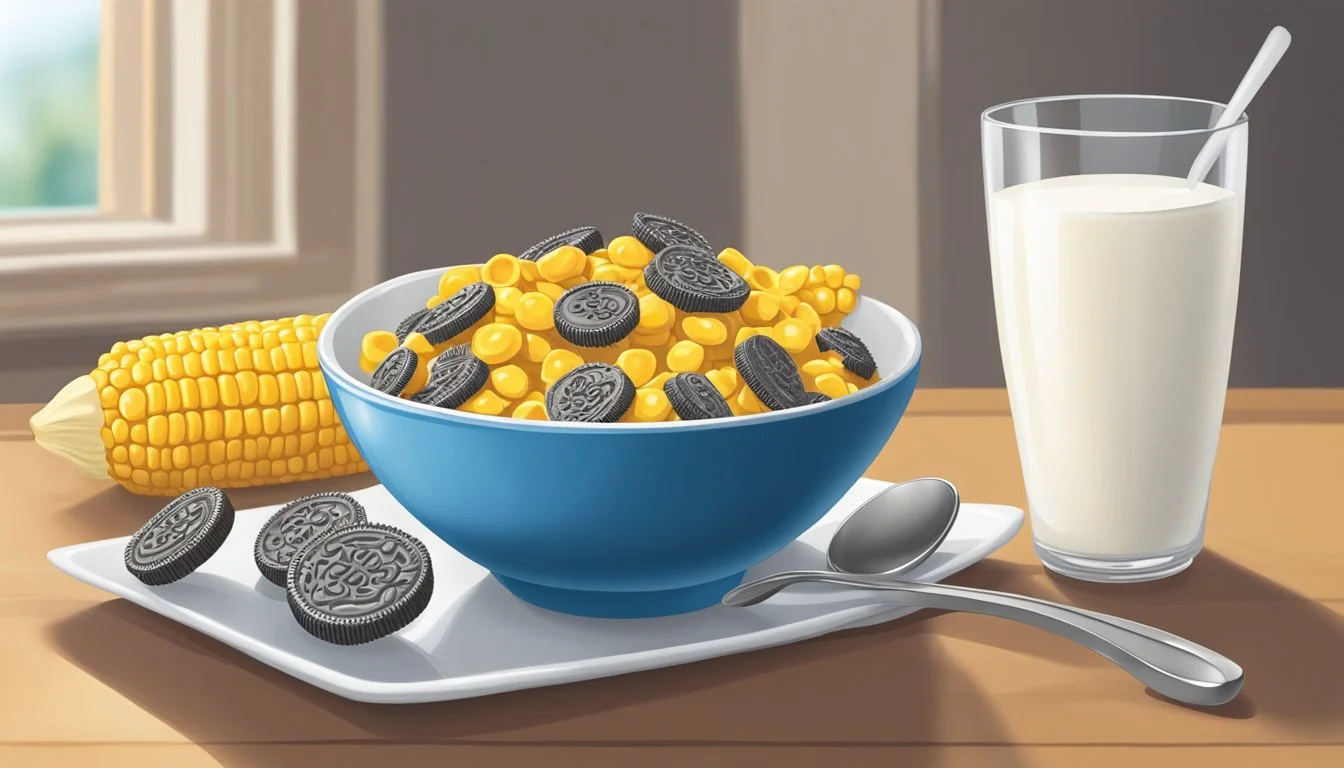Corn Pops vs Oreo O's
Comparing Popular Breakfast Cereals
This Article is Part of Our Breakfast Cereal Guide with Details on Corn Pops Nutrition and Oreo O's Nutrition
With a plethora of cereal options available, two of the most iconic choices are Corn Pops and Oreo O's. Each brings its own unique taste and nutritional profile to the breakfast table, sparking debates among cereal enthusiasts. Corn Pops offer a slightly sweet taste with a crispy texture, while Oreo O's capture the essence of America's favorite cookie in a bowl.
Parents and health-conscious individuals might lean towards Corn Pops, which are renowned for their balanced sweetness and modest sugar content. In contrast, Oreo O's appeal to those seeking a more indulgent start to their day, loaded with the distinctive flavor of Oreo cookies and a higher sugar content.
Whether you prioritize nutrition or just can't resist the allure of cookie-flavored cereal, the choice between Corn Pops and Oreo O's boils down to your breakfast preferences. Both cereals bring something special to the table, from Corn Pops' nostalgic charm to Oreo O's decadent taste. Dive into this comparison to discover which cereal truly deserves a spot in your pantry.
History and Evolution
Corn Pops and Oreo O's have rich histories marked by their evolutions over the years. Each cereal has distinct origins and has undergone significant changes since its introduction.
Origins of Corn Pops
Corn Pops were introduced by Kellogg’s in 1951. Initially known as "Sugar Pops," they were marketed as a sweetened corn cereal aimed at children. By 1978, the name changed to "Sugar Corn Pops" to reflect its composition more accurately.
In 1984, the cereal was rebranded as "Corn Pops" to appeal to a broader audience and reduce the emphasis on sugar. This rebranding coincided with growing health consciousness among consumers. Corn Pops remained popular for their light, sweet taste and distinctive texture, setting them apart from other breakfast options.
Development of Oreo O's
Oreo O's first appeared on the market in 1998, developed by Post Cereals in collaboration with the popular Oreo cookie brand. The initial recipe comprised O-shaped cereal pieces with the flavor of Oreo cookies.
In 2001, Oreo O's introduced a new recipe featuring real creme filling to enhance its authenticity. The cereal was discontinued in the U.S. in 2007 due to a split in partnerships but continued to be sold in South Korea. In 2017, Post Cereals reintroduced Oreo O's in the U.S., reigniting its popularity among nostalgic consumers.
Both cereals have their unique legacies and continue to be cherished by breakfast aficionados worldwide.
Nutritional Comparison
Examining the nutritional profiles of Corn Pops and Oreo O's cereals highlights key differences in their caloric content, macronutrients, and vitamin and mineral fortification.
Caloric Content and Macronutrients
Corn Pops provide 150 calories per 1.33 cup (40g) serving. They contain no fat or fiber but offer 2g of protein. Each serving also delivers 35g of carbohydrates, including 13g of sugar.
Oreo O's contain 160 calories per 1.25 cup (41g) serving. This cereal includes 2g of total fat, 1g of fiber, and 1g of protein. The carbohydrate content is 34g, with 13g coming from sugars.
Both cereals have similar sugar content. Corn Pops lack fiber, whereas Oreo O's include a small amount. Neither cereal is particularly high in protein.
Vitamin and Mineral Fortification
Corn Pops are fortified with several vitamins and minerals. A typical serving provides 10% of the daily value (DV) for iron, 25% DV for thiamin, niacin, and folate, and 25% for vitamin B6. They also include 2% of the DV for calcium.
Oreo O's are also fortified but in different amounts. Each serving offers 10% DV for iron, around 10-25% DV for thiamin, niacin, and folate, and approximately 10% DV for calcium.
Both cereals provide essential vitamins and minerals, but Corn Pops deliver higher percentages for B vitamins, whereas Oreo O's offer a broader mix but in smaller quantities.
Ingredient Profiles
Corn Pops and Oreo O's both have distinct ingredient lists that cater to different taste preferences and dietary needs. These cereals include a mix of main ingredients, additives, and allergens, which are crucial for understanding their nutritional implications.
Main Ingredients and Additives
Corn Pops:
Main Ingredients: Cornmeal, sugar, molasses, salt
Additives: Corn syrup, high fructose corn syrup, hydrogenated oils
Corn Pops primarily consist of cornmeal, making them a classic corn-based cereal. The sugars listed include both corn syrup and high fructose corn syrup, which contribute to the cereal’s sweetness. Some ingredients, like hydrogenated oils, are added for texture and shelf stability.
Oreo O's:
Main Ingredients: Whole grain oat flour, sugar, corn syrup
Additives: Artificial flavor, artificial colors, palm oil
Oreo O's stands out with its whole grain oat flour as a base ingredient, which adds some nutritional value. Like Corn Pops, it also includes corn syrup and sugar for sweetness. The cereal contains palm oil and various artificial additives to closely mimic the flavor of Oreo cookies.
Allergens and Dietary Considerations
Corn Pops:
Allergens: Contains gluten, may contain traces of nuts
Dietary Considerations: Not gluten-free
Corn Pops include ingredients that could be problematic for those with gluten sensitivities or celiac disease. Due to its production processes, it may also have traces of nuts, which is important for those with nut allergies to note.
Oreo O's:
Allergens: Contains wheat, soy, and dairy
Dietary Considerations: Contains artificial colors and flavors
Oreo O's list wheat, soy, and dairy among its allergens, making it unsuitable for those with allergies to these ingredients. The inclusion of artificial colors and flavors might be a consideration for individuals trying to avoid such additives in their diet.
Flavor and Texture
Corn Pops and Oreo O's offer distinct flavor profiles and textures that appeal to different tastes. While Corn Pops provide a sweet, corny taste, Oreo O's mimic the iconic flavor of Oreo cookies.
Taste Profile
Corn Pops deliver a subtle, sweet corn flavor that is less intense than many other sugary cereals. The taste is light and not overly complex, making it a go-to for those who prefer a straightforward, sweet cereal.
In contrast, Oreo O's exude the rich, chocolatey taste of Oreo cookies. This cereal features a robust cocoa flavor combined with a hint of the signature Oreo creme. Fans of chocolate cereals like Cocoa Puffs or Cookie Crisp will likely appreciate this blend.
Cereal Consistency and Milk Interaction
Corn Pops have a crunchy texture that stands up well to milk initially. However, they tend to soften relatively quickly, transitioning from a firm bite to a more tender consistency. This texture shift can appeal to those who enjoy a variety of mouthfeel experiences in one bowl.
Oreo O's maintain a more consistent crunch throughout the eating process. When combined with milk, the cereal pieces absorb just enough to enhance their chocolate flavor without becoming mushy. This quality is akin to the experience of eating chocolate-flavored cereals like Chocolate Lucky Charms, leaving the milk with a delightful chocolate essence.
Consumer Experience
Corn Pops and Oreo O's offer distinct consumer experiences, influenced by factors like packaging, branding, availability, and pricing. These elements are key in shaping the overall enjoyment and accessibility of these cereals for consumers.
Packaging and Branding
Corn Pops, known for its bright yellow packaging, aims to capture attention with a playful and energetic vibe. The brand's central image – a picture of the cereal itself – reinforces its classic appeal. This design seeks to invoke nostalgia while appealing to new age consumers.
Oreo O's, on the other hand, leverages the iconic status of Oreo cookies. The box frequently features the recognizable Oreo branding with a blue and white theme. Limited edition varieties like Mega Stuf Oreo O's and Golden Oreo O's continue to diversify the brand's image and attract fans of the original cookie.
Availability and Pricing
Corn Pops is widely available in major grocery stores, including Walmart. This cereal is often found in the breakfast aisle, making it an easy find for shoppers. In terms of pricing, Corn Pops tends to be moderately priced, accessible to a broad range of consumers.
Oreo O's, while also widely available, might sometimes be limited in certain editions. The original flavor can usually be found in large grocery chains, but special editions like Golden Oreo O's might have more sporadic availability. Pricing varies slightly, often reflecting the novelty of themed editions, but remains competitive in most retail locations.
Health and Diet
When comparing Corn Pops and Oreo O's in terms of their health impact and role in a balanced diet, several factors like sugar content, fiber, and nutritional value are essential. Examining these cereals provides insight into making healthier breakfast choices.
Cereals in a Balanced Diet
Corn Pops, produced by Kellogg's, provides 120 calories per serving, with 14 grams of sugar and a negligible amount of fiber. While its sugar content is significant, it is relatively low in fat. This makes it a less ideal choice for those seeking nutritious options rich in whole grains or fiber.
On the other hand, Oreo O's contains 13 grams of sugar per serving and lacks dietary fiber. Its high sugar content and low nutritional value categorize it as more of a sugar-laden treat rather than a healthful breakfast option. As a result, consumers mindful of their sugar intake and overall health may find it better suited as an occasional indulgence.
For a balanced diet, cereals with whole grains and higher fiber like Fiber One are recommended. These options typically provide sustained energy levels and support digestive health, unlike more sugary cereals. Incorporating such cereals can help maintain a healthier diet.
Cereal Calories per Serving Sugar Content (g) Fiber (g) Fat (g) Corn Pops 120 14 <1 0.5 Oreo O's 160 13 <1 2
Cereals in Popular Culture
Cereals like Cheerios, Cinnamon Toast Crunch, and Cocoa Krispies have cemented their place in popular culture through memorable marketing campaigns and nostalgic associations.
Marketing Campaigns and Mascots
Popular cereals often rely on iconic mascots and catchy marketing campaigns. Cheerios has its Cheerio Kid, a character promoting health benefits. Cinnamon Toast Crunch introduced the whimsical Cinnamon Toast Crunch Squares, who make mischievous fun in their ads.
Frosted Flakes' Tony the Tiger is known for his "Grrreat!" slogan, making the cereal synonymous with energy and fun.
Cap’n Crunch has its seafaring mascot, creating adventures through commercials and print ads. These mascots help solidify brand identity and engage both children and adults, integrating cereals into daily conversations and popular media.
Cereals and Nostalgia
Breakfast cereals play a significant role in evoking childhood memories. Many adults recall mornings with Trix and its colorful rabbit mascot, or the thrill of finding marshmallows in Lucky Charms.
Oreo O's, a '90s favorite, was discontinued in 2007, only to make a triumphant return a decade later due to popular demand.
Such cereals remind people of simpler times, contributing to their enduring popularity. These nostalgic elements are often used in marketing to re-engage older audiences while attracting new consumers, thus ensuring that these brands remain relevant across generations.
Environmental and Ethical Considerations
When comparing Corn Pops and Oreo O's, it is essential to look at their impact on the environment and the ethics behind their ingredient sourcing. Factors such as sustainable practices and the ethical sourcing of ingredients play a significant role.
Sustainable Practices
Companies making Corn Pops and Oreo O's have made various commitments to sustainability. Mondelēz, the maker of Oreo O's, has expanded its Harmony program to achieve 100% sustainable wheat for all European biscuits. This indicates a focus on sustainable agriculture for some of their production lines.
Kellogg's, the manufacturer of Corn Pops, has also made strides in sustainability. They work toward responsible sourcing and aim to reduce their overall environmental impact. Both companies face challenges related to packaging waste and energy usage in manufacturing, areas continually needing improvement for truly sustainable products.
Ethical Sourcing of Ingredients
Examining the ethical sourcing of ingredients reveals key differences. For Oreo O's, palm oil is a notable ingredient. The sourcing of palm oil has significant environmental concerns due to deforestation and habitat destruction. Responsible sourcing and certifications like RSPO (Roundtable on Sustainable Palm Oil) are critical measures for mitigating these impacts.
Corn Pops include preservatives like BHT, which has raised health debates. Ethical considerations also extend to genetically modified ingredients. For example, the sugar in Oreos often comes from genetically modified sugar beets, a common practice in large-scale agriculture.
Overall, understanding the origins and environmental impacts of each product's ingredients is crucial. Ethical sourcing involves addressing the broader implications of ingredient choices, emphasizing transparency and responsibility toward sustainable and humane agricultural practices.







